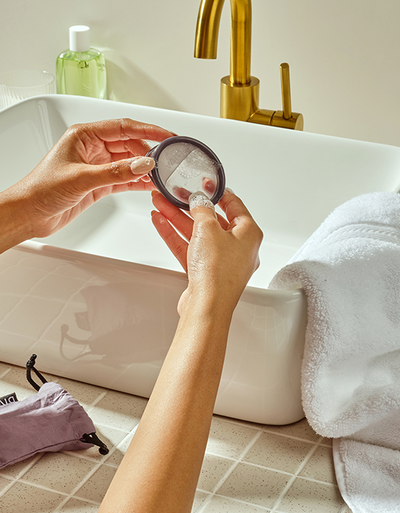

Les 5 principales raisons pour lesquelles vous pourriez hésiter (et pourquoi vous ne devriez pas !)
1. Vous craignez que ce soit compliqué et difficile à changer dans les toilettes publiques
Même si cela peut être compliqué lorsque vous apprenez encore à utiliser une coupe ou un disque menstruel (ils sont après tout conçus pour recueillir le sang), ce ne sera pas toujours le cas ! Nous recommandons souvent de pratiquer l'insertion et le retrait sous la douche pendant que vous êtes encore en apprentissage.Selon notre experte résidente en santé pelvienne, physiothérapeute du plancher pelvien, Keri Martin Vrbanac, il n'y a aucun mal à pratiquer même lorsque vous n'avez pas vos règles. « Vous ne voulez jamais mettre de tampon lorsque vous n'avez pas vos règles parce que vous ne voulez pas retirer un tampon sec. Vous laissez des fibres et autres derrière vous et ce n'est tout simplement pas génial. Mais la coupe ne fera rien pour endommager les tissus, que vous la mettiez dedans si vous avez vos règles ou non.
L’avantage d’une coupe menstruelle est qu’elle collecte et n’absorbe pas le flux menstruel. Les coupes menstruelles peuvent être utilisées en toute sécurité jusqu'à 12 heures sans les mêmes risques de syndrome de choc toxique (SCT) associés aux tampons. De plus, ils sont plus écologiques, plus confortables et peuvent être nettoyés facilement avec juste un Shaker Cup et DIVA Wash.
2. L’insertion, le retrait et la recherche du bon positionnement semblent intimidants
L'anatomie de chacun est unique. Et il faudra un certain temps pour s’assurer qu’il soit sûr et confortable à porter. D’un autre côté, nous avons également entendu dire que cela pouvait être assez intuitif !Les coupes et les disques menstruels se replient jusqu'à la taille d'un tampon, l'insertion ne devrait donc pas être plus difficile. (La douceur du silicone 100 % de qualité médicale peut même signifier qu'il glisse plus facilement qu'un tampon sec !)
L'une des meilleures nouvelles que vous recevrez est que la cavité vaginale n'est pas connectée au reste du corps et qu'elle n'a donc aucun endroit où aller . Le canal vaginal mesure en moyenne 15 à 37 mm (0,6 à 1,5") de largeur et la cavité vaginale (ou le nombre que vous obtenez lorsque vous mesurez la hauteur de votre col ) mesure entre 45 à 55 mm (1,8 à 2,25") de longueur. Et Keri, notre experte en santé pelvienne, le confirme.
« Les coupes menstruelles sont incroyablement sûres. Il n’y a vraiment nulle part où aller pour la coupe, donc elle ne sera jamais perdue.
Les nouvelles utilisatrices de coupe menstruelle auront juste besoin d'un peu de temps, d'intimité et d'essais et d'erreurs pour expérimenter le positionnement. Ce n'est pas différent de lorsque vous appreniez à utiliser un tampon !
3. Vous craignez que cela vous fasse mal et/ou soit inconfortable à porter
Keri explique : « généralement lors de l'insertion et du retrait, l'une des principales raisons pour lesquelles les gens ressentent de la douleur est le stress associé à ce qu'ils font. »« Il existe une corrélation directe entre le stress et le plancher pelvien. Par exemple, lorsque nous sommes nerveux et généralement lorsque nous utilisons la coupe, surtout au début, le stress se répercute sur le plancher pelvien. Votre plancher pelvien devient tendu et il est plus difficile de faire entrer ou sortir la coupe. Prendre une profonde respiration et apprendre à se détendre pendant l’insertion et le retrait peut faire toute la différence !
Une fois en place, la DIVA Cup ou DIVA Disc est si confortable que vous ne remarquerez pas sa présence. Les bonnets DIVA de différentes tailles, ainsi que le disque DIVA, s'adaptent mieux à différentes personnes, et notre équipe Expérience consommateur peut vous aider à trouver la taille adaptée à votre anatomie personnelle.
4. Vous avez peur de vous sentir sale ou de sentir une odeur
Changer votre coupe ou disque menstruel peut être effectué rapidement et avec un minimum de dégâts. Bien que parfois vous puissiez vous retrouver avec un peu de liquide menstruel sur vos mains, vous apprendrez à vous y retrouver rapidement en le rinçant ou en l'essuyant avec du papier toilette.L’avantage de voir le liquide menstruel est qu’il peut vous donner des indications sur la santé de votre flux. Un écoulement rouge vif est sain, mais un peu de sang brun au début ou à la fin est également tout à fait normal. La cohérence peut aussi nous dire des choses, et cela vaut donc la peine de prendre contact avec cet incroyable bulletin mensuel.
Le sang menstruel, ainsi que les pertes vaginales, ne doivent pas avoir une odeur de poisson ni une odeur forte. Vous remarquerez peut-être une légère odeur métallique, mais rien de plus reconnaissable avec une coupe menstruelle qu'avec un tampon.
Si vous ressentez une odeur vaginale forte ou de poisson, n'hésitez pas à consulter votre professionnel de la santé.
5. C'est cher/cela semble être un investissement trop important
L'achat d'une coupe ou d'un disque menstruel est un investissement ponctuel et dure jusqu'à plusieurs années avec un entretien approprié !Si vous y réfléchissez bien, vous achetez actuellement des serviettes et des tampons tous les mois. Chaque paquet coûte environ 10 à 15 $ et vous achetez peut-être des serviettes hygiéniques, des tampons, des serviettes de nuit ET des protège-dessous. Bien que vous ne puissiez pas parcourir tout cela en un seul cycle, vous aurez payé votre DIVA Cup ou DIVA Disc dans un délai de 3 à 4 cycles par rapport à ce que vous auriez dépensé en produits jetables. Une coupe menstruelle plutôt qu'un tampon est l'option la plus écologique et la plus rentable, qui dure plus de 20 cycles supplémentaires !
Cet été, découvrez ces raisons supplémentaires et spécifiques de faire le changement ; natation/sports nautiques et journées à la plage, randonnée/camping dans l'arrière-pays/dormir dans une tente, assister à des festivals ou à des concerts, ou si vous voyagez.
Cette série en quatre parties couvrira les spécificités de chacune de ces activités, si vous devez choisir une coupe ou un disque menstruel, ainsi que quelques conseils d'experts pour vous assurer que vos règles n'interrompent pas le plaisir. Restez à l'écoute!









